The most important driving link of a modern washing machine is its electric motor. He is responsible for the rotation of the drum in the washing, rinsing and spinning modes. And if it breaks, the device will freeze. Is it possible to repair the engine of a washing machine with your own hands, without resorting to the help of experienced professionals?
With straight hands and certain skills in repairing simple household appliances, you can repair anything, including the engine of a washing machine. If you are sure that the reason for the lack of performance is a malfunction of the engine, you can proceed with its removal and repair work.
Before you start repairing the washing machine engine, you need to get information about the type of engine used in a particular machine, because depending on washing machine type, it can have a different type of engine. A brushless asynchronous motor, a simple commutator motor, or a direct drive motor can be installed here.
Asynchronous motors are highly resistant to breakdowns, but they are rarely used in modern washing machines. Another thing collector motors - they work on the vast majority of devices. They are characterized by good technical data and low cost, they can work up to 8-10 years.
In addition to machines with commutator motors, there are models with direct drive on the market. They use special engines, which are almost impossible to repair on their own. Yes, and manufacturers give them such a long warranty that it is easier to give a broken engine for repair to a service center.For example, LG motors have a 10-year warranty.
Removing the motor from the washing machine
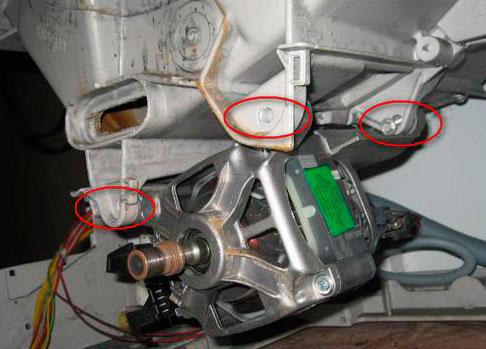
But back to our commutator engine. How are we going to repair it? First, we'll look at how to remove it. First of all, remove the back cover and belts in the same way as with washing machine belt replacement. After that, we proceed to remove the bolts holding it - the fastening system may differ slightly. Also, do not forget to disconnect the connecting terminals with which the engine is connected to the supply wires.
In some models, the engine may be clamped by the tank itself. In this case, the tank will need to be slightly raised, which will allow the motor to be released with relative ease. By the way, the number of bolts holding the engine may vary - prepare a set of keys to remove them.
The back cover does not allow you to get to the engine and remove it? Then try to remove one of the side walls - it is quite possible that this is where access to the engine will be.
Motor malfunction detection
Collector motors have one important advantage - simplicity. Three things most often break here - brushes, lamellas, windings. Let's figure out how to inspect the nodes and identify the malfunction.But before that, let's try to start the engine, since we need to see if it will work or not.
To start the engine, you need to connect the rotor and stator windings in series, and then connect an AC source with a voltage of 220 volts to the remaining connectors. If all is well, the engine will start to rotate. At this time, we can determine its noise, identify sparkling brushes.
brushes
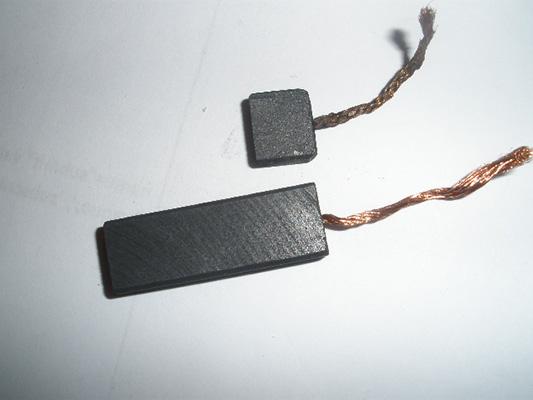
If your washing machine is about 10 years old, then the brushes will be in a terrible state - this is most often indicated by a strong engine spark. Worn brushes are small, you will see it right away. If the brush is intact, then it will be long enough, without chips or cracks. If this is not the case, then a replacement must be made.
To replace the brushes, try to use original components - thanks to this, the service life of the repaired engine will increase. Choose washing machine brushes and replacing them yourself is a simple matter, but responsible.
Rotor and stator winding

If the motor runs with strange noises or does not reach full power, it buzzes a lot or heats up, then the cause of this may be a malfunction of the windings. The windings are checked using the most common multimeter (in ohmmeter mode), by successively touching the probes to adjacent lamellas. The discrepancy in resistance should not exceed 0.5 ohm. If this is not the case, then we can diagnose an interturn short circuit.
We also need to determine the performance of the stator - this is done in a similar way. Lastly check the closure of all windings on stator or rotor iron (on the body). To do this, we use a multimeter, attaching one probe to the body, and the second passing through the lamellas and the output of the stator windings.
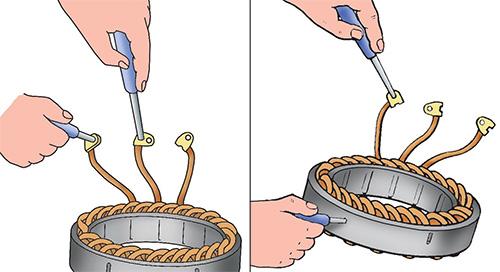
If the windings are in good condition, then the resistance will be very high (tens and hundreds of megaohms).
Lamella wear
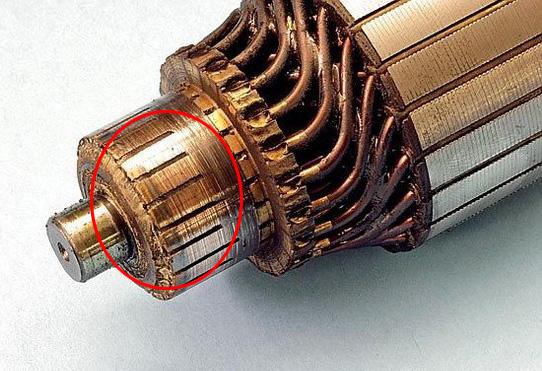
Diagnosing lamella wear is as easy as diagnosing brush wear. To do this, you just need to inspect the manifold, completely removing the rotor from the engine. Peeling of the lamellas, breakage of the supply contact, the presence of burrs - all this leads to the fact that the brushes begin to spark.
The reason for the peeling of the lamellas is the jamming of the rotor or the presence of an interturn short circuit. As a result, the lamella begins to overheat and flake off.If the contact is broken at the junction with the lamella, then there may be a variety of reasons, but it can be very difficult to return the wires back.
Replacing brushes on a washing machine motor
The brushes on the commutator motors are quite easy to change. Only some models can give us some inconvenience - sometimes the brush mounts are hidden in the depths of the engine, so it has to be completely disassembled. This is typical for old engines, and in new models everything is much easier - you can get by with an ordinary screwdriver, prying it with fasteners that protrude near the collector itself.
If your machine has an old-style motor with closed brushes, then it needs to be disassembled.Try to disassemble it so that it can be easily and quickly returned to its original state without confusing anything. As a last resort, take pictures of your every step. After replacing the brushes, try to rotate the engine - the brushes should rustle softly over the lamellas, without strong noises, without clinging to them.
What to do if the winding is faulty
What should we do if we find a short circuit or open circuit? The best option is to find the same rotor or the same stator. If we give the engine for rewinding, then they will take so much from us that it will be enough for a new engine and there will still be change. This is due to the fact that in addition to rewinding, the rotor must be centered to avoid its beating.
Grooving lamellas yourself
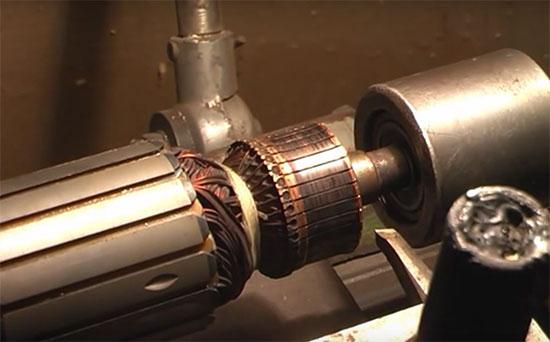
Have the lamellas peeled off? Then you need to assess the scale of the disaster. If the lamella has peeled off literally by 0.5 mm, an ordinary groove on a lathe will help - we clamp the rotor and carefully align the thickness of the lamellae. After that, we carefully clean the gaps between the lamellae, they should not leave traces of metal chips.
As a result, we get a flat surface from many lamellas, with well-cleaned gaps - in order to verify this, we check the resistance between the lamellas with an ohmmeter. If the ohmmeter shows a short circuit, then the gaps between the lamellas need to be cleaned more thoroughly.
By the way, the groove of the lamellas does not always give positive results, since most often we eliminate the effect, not the cause. It should also be remembered that it is almost impossible to return the lamellas to their factory appearance, therefore the groove is not a panacea. If the lamella has completely peeled off or come off, you should send the engine to the trash can - nothing can be done here at home.
Do not despair if the engine could not be repaired, because with it you can make various homemade from a washing machinesuch as a grinder.

Comments
God forbid buying Russian-made LG washing machines is like playing Russian roulette
Good afternoon! there is an indesit wdn 867 wf machine (I know an old woman, but I love it). problem: poor spin, the engine keeps speed much less during spin than before. there is a two-speed indesco 940p1I engine (two windings) upon visual inspection, it can be seen that the winding on the rotor has closed and burned. there is a c.e.set mca 38/64 engine, one-to-one mount, but it is single-speed, therefore there are only 4 pins per chip, and not 6 as in the native one. question: can it be used and how to connect (change the pinout) so that it works as it should?
Good afternoon, the engine has lost speed, I even brake it with my hand, the brushes are in order, the lamellas are also in order, please tell me what to do